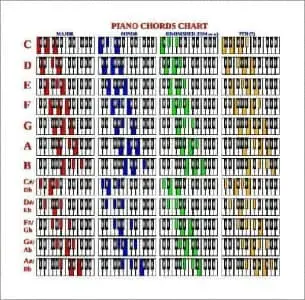

For example, the A minor chord is written, “Am.” Sometimes you see “min” instead of just “m,” but that is less common. In chord symbols, a capital letter and then a lower case “m” indicates a minor chord. See if you can make every possible minor chord, all twelve of them. This tiny change makes a big difference in sound. You might have noticed that to change from a major to a minor chord, all you have to do is to move the third (the middle tone) down by one half-step. If you want to make a D minor chord, you’ll use D, F, and A. Four more half-steps up (a major 3rd) brings us to G. To use C as an example again, the C minor chord will have the same root, the C, but then going up three half-steps (a minor 3rd) takes us to an E-flat. To make a minor chord, start on any of the twelve tones of the chromatic scale. Minor goes on bottom, major goes on top, and the fifth goes in the same place when constructing chords. It puts the minor 3rd on the bottom, from root to third, and major 3rd on top, from third to fifth. That’s all there is to it.Ī minor chord is built like an upside-down major chord. For an E major chord, you’ll see a capital “E” above the staff. For major piano chords, you’ll simply see the letter name of the root as a capital letter. Now, back to those letters above the musical staff. This is because their notes have the same relationship to each other. You can hear how all of the major chords sound similar. If you have your piano keyboard handy, see if you can play each major chord, one for each of the twelve tones. Your E-flat major chord is E-flat, G, B-flat. Count up four half-steps to G, then three half-steps to B-flat. Now, say you want to start on a black key, such as E-flat. Then count up three more half-steps from F-sharp, and you get A. Count up four half-steps from D, and you get F-sharp. This is how you build a major chord on top of ANY of the twelve tones of the chromatic scale. The top two notes of the chord, from the third to the 5th, will be three half-steps apart, or a minor 3rd. Between the root and the third you will always have four half-steps, an interval known as a major 3rd.

This is because the number of half-steps between each of the notes will always be the same. All major chords sound similar no matter what note they have for their root. The fifth will be the fifth tone of the C major scale, or the note G. The third is going to be the third tone of the C major scale, or the note E.

The C major chord, for example, will have a C as its root and lowest note.

Major and minor chords are made up of three tones, called the root, the third, and the fifth. Ninety-nine percent of all popular music, and a great deal of classical music, is built on these two kinds of chords and their variations. When you make a chord, the distance, measured in half-steps, between the tones of a chord determines what kind of chord it is.Ĭhords in modern-day Western music are mostly either major chords or minor chords. As you go up the keyboard, twelve half-steps will bring you right back to where you started in the sequence of tones. Each white or black key is included in the scale, and is a half-step away from the keys next to it. The piano keyboard has only twelve different tones, which make up the chromatic scale, and they repeat as you go up the keyboard. So which notes make which chord? With eighty-eight keys on the piano, that makes an impossible number of combinations for creating chords, right? Actually it’s simpler than that. Most simply put, if you play more than one note at a time you’ve got a chord.
#ALL CHORDS PIANO FREE#
Sign up for a free account now and learn with over 300 video lessons (and counting!) accessible on any smart device.
#ALL CHORDS PIANO HOW TO#
In this article, I’ll show you how to make basic and advanced piano chords, how to read chord symbols, and how to use chords to make your piano playing more amazing than ever. But for folk, jazz, pop, and rock musicians, chords are the foundation of how they think about, play, and perform music. Although guitar players use chord symbols all the time, for many beginning piano students chords are a mysterious art. Have you ever seen those letters up above the staff in your sheet music and wondered what they are? Those letters are chord symbols. This is a great place for beginners to start! Learn how to play piano chords with the help of our piano chord charts.


 0 kommentar(er)
0 kommentar(er)
